- This chapter is about how to put together a packet-switched WAN
using long distance digital communication lines and routers.
- a LAN spans a single building or campus
- a MAN can span a city
- a WAN spans sites in multiple cities, countries, or continents.
Scalability is the key feature of a WAN
technology.
-
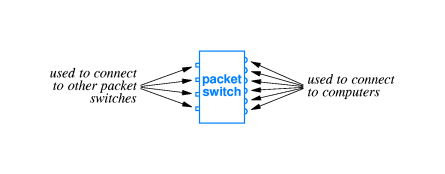 The basic element of a WAN is a "packet
switch." Many individual computers are connected to "I/O
connectors" on the switch.
The basic element of a WAN is a "packet
switch." Many individual computers are connected to "I/O
connectors" on the switch.
- Other (high speed) I/O connectors on the switch connect over long
distances to more switches, which are connected to more computers.
- There are many different kinds of WAN's,
employing many different kinds of hardware and software for their
packet switches.
-
 One chooses the speed and capacity of each switch-to-switch
connection with care. It is important to match speed and capacity
to the anticipated traffic.
One chooses the speed and capacity of each switch-to-switch
connection with care. It is important to match speed and capacity
to the anticipated traffic.
- Usually one connects each switch to at least two other switches.
If one connection fails, communication can continue through
another.
- Unlike a LAN, in a WAN large numbers of packets move through the
network at the same time.
- Switches are special purpose computers. When packets arrive at a
switch they are stored and forwarded: examined by software
running on the switch, placed in a queue corresponding to the
interface from which they need to exit, and transmitted when the
interface is ready.
- The typical WAN has a standard frame format
and frame addressing rules. This is just like the situation in a
LAN, which has the same kind of rules. Of course, the
rules and standards are different for different kinds of WANS, and
also different from the rules and standards of LANS.
-
 Most WAN addresses are hierarchical.
For example the first half of an address can determine the identity
of the destination switch, and the second part of the address can
determine which host on the switch.
Most WAN addresses are hierarchical.
For example the first half of an address can determine the identity
of the destination switch, and the second part of the address can
determine which host on the switch.
- Switches have to be concerned with routing.
- If a switch S gets a packet addressed to a
computer C attached directly to S, then S must transmit the
packet onto its interface with C.
- If a switch S gets a packet addressed to a
computer K attached to a switch T directly connected to S,
then usually S will transmit the packet onto its interface with T.
- If a switch S gets a packet addressed to a
computer J attached to a switch W not directly connected
to S, then ordinarily S should transmit the packet to a
switch X that is "closer" to W. "Closer" usually means that there
are fewer links (hops) between X and W than there are between S and
W. This kind of routing is called "next-hop."
-
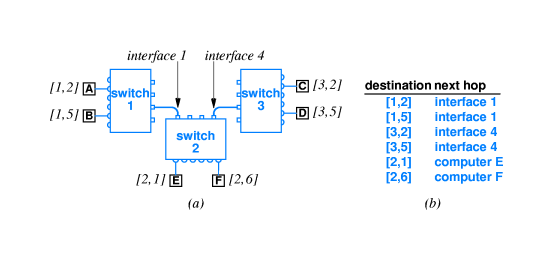 Typically, switches use a table of routes to perform routing. The
table in the figure shows the routing table for switch #2. It has a
column of destinations and a column of corresponding interfaces for
the next hop. (See figure.)
Typically, switches use a table of routes to perform routing. The
table in the figure shows the routing table for switch #2. It has a
column of destinations and a column of corresponding interfaces for
the next hop. (See figure.)
- To route a packet, software on the switch
looks up the destination address in the routing table and
sends the packet out on the corresponding interface.
- Information in the table may be preloaded, discovered by
distributed algorithms performed by switches, or some combination
of those techniques.
- Usually the source address of a packet (the address it came from)
plays no role in determining the packet's next-hop.
- In other words, typically routing algorithms "don't care" where a
packet came from.
- Routing algorithms only "care" about how to send a packet on its
way from its current location to its final destination.
- The job of the router is relatively simple when the routing
decision is based solely on the destination address.
- On the other hand, it is possible to send packets by different
routes based on characteristics of the packets, including source
address. Considerations like this can come into play when there
are different "qualities of service" available.
- Routing is very demanding on processors and
memory. The number of hosts N in a WAN can be very large.
Routing may be too inefficient if it takes O(N) memory or time to
route each packet.
- It should be possible to determine routes with a quick hash or
associative search.
- Routing tables should be made as compact in size as possible.
-
 Hierarchical addressing schemes facilitate
construction of compact routing tables with quick indexing.
For example, a switch can just use the destination switch
number as an index into a routing table and read off the next hop
for the packet. This is a very quick alternative to searching the
table for each route. (See figure.)
Hierarchical addressing schemes facilitate
construction of compact routing tables with quick indexing.
For example, a switch can just use the destination switch
number as an index into a routing table and read off the next hop
for the packet. This is a very quick alternative to searching the
table for each route. (See figure.)
- However, if the destination switch is the local switch then the
local switch must route the packet out one of its host interfaces,
based on the host part of the address. There can be a separate
table for that local routing.
- An exterior switch in a WAN is a switch that connects directly to
one or more computers.
- An interior switches in a WAN connects only to other switches.
-
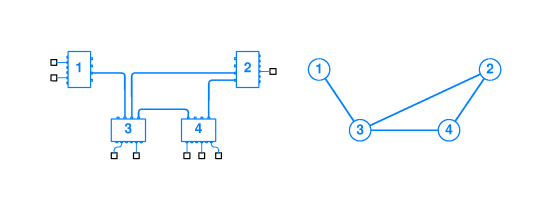 If a switch S in a WAN becomes overloaded,
the network architects can "split" S. They add another
switch T to the network, disconnect some of the connections to S,
and reconnect them to T. This is how WAN's
grow.
If a switch S in a WAN becomes overloaded,
the network architects can "split" S. They add another
switch T to the network, disconnect some of the connections to S,
and reconnect them to T. This is how WAN's
grow.
-
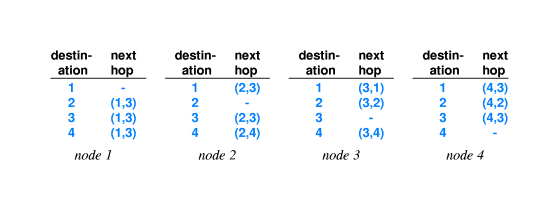 For this to work, each switch must do routing -- generally "shortest
path routing.". The figure shows shortest path routing tables for
switches 1-4.
For this to work, each switch must do routing -- generally "shortest
path routing.". The figure shows shortest path routing tables for
switches 1-4.
- Using a default route in a routing table can
help to keep the table compact. All routes are explicit
except the default route. The switch checks first to see if there
is an explicit route. If not the packet is sent out the interface
of the default route.
-
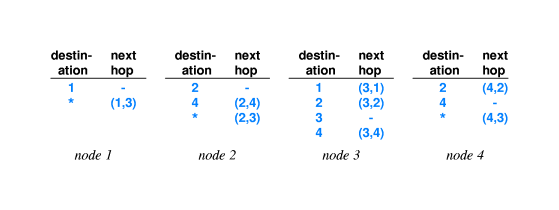 The figure shows how some of the previous routing tables can be
shortened by taking advantage of default routes.
The figure shows how some of the previous routing tables can be
shortened by taking advantage of default routes.
- A switch can boot with some routing
information already in memory. Other (static) information can be
downloaded from neighboring switches at boot time.
Switches may dynamically cooperate to modify routing tables as
network conditions change.
- Big networks have redundant links and
dynamic routing. Routing software can automatically route
traffic "around" a failed link.
-
Dijkstra's single source, all nodes, shortest paths algorithm
is often used to compute the "shortest" distance from one switch to
another. Such computations determine the content of the routing
tables. A packet is always sent to the next switch along the
shortest path.
-
Photo of Edsger Dijkstra
-
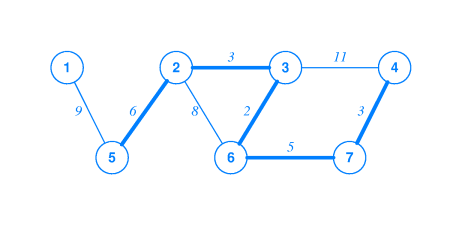 The algorithm actually computes the "cheapest" route. The cost of
each link can be assigned as desired -- whatever best describes the
true cost of traversing the edge.
The algorithm actually computes the "cheapest" route. The cost of
each link can be assigned as desired -- whatever best describes the
true cost of traversing the edge.
- The cost does not have to be the length of the link. For
instance, the cost could be some function that takes into account
the time delay on the line (and delay can change over time).
- If there are "political" reasons to discourage using some links
(e.g. they aren't "ours") then the metric can be adjusted to make
those links costly.
- One disadvantage of using Dijkstra's
algorithm to calculate routes is that it is necessary to have in
advance a complete representation of the graph of the network.
- An alternative is to let switches "learn"
about routes by sending messages periodically to their
nearest neighbors. After a short time all switches can learn the
best routes. Also, if a link or switch fails, new routes can be
discovered.
The distributed distance vector algorithm for building dynamic routing tables goes as described below. Note that this version does not handle the case of broken links or failed switches.
- A switch X periodically sends the contents of its routing tables to
the switches directly connected to X.
- The other switches do likewise.
- When X gets routing information from Y it interprets them as a
series of messages of the form "I can get
to Z over a path of distance equal to D." X knows the
distance to Y is C. Therefore X knows that X can get to Z over a
path of distance equal to D+C.
- If X has a route to Z that has a longer distance than D+C, then it
will delete that route.
- If X now has no route to Z, it will make a new entry in the table
that says to send packets addressed to Z to Y. The entry will also
say that the distance to Z is D+C.
- If X is already routing packets for Z to Y, X will check the
distance field of the route table entry and set it to D+C because
the distance may be new because of route changes in the tables of
other switches.
- (Basically you handle failed links and switches by deleting a
route to a directly connected switch if it has not contacted you
in a long time.)
- Another version of dynamic routing (SPF)
calls for switches to broadcast knowledge of "edges" in the graph
of the network.
- Switches then build a representation of the
graph and run Dijkstra's algorithm on it to build a
routing table.
- This algorithm will be adaptive too, if edges are removed when
they are not re-announced after a long time, and if the routing
tables are re-computed when the representation of the graph
changes.
- 13.17.1 ARPANET
- Funded by the Defense Department.
- One of the first packet switched WAN's
- Much of the important fundamental research on protocols for
packet switched networks was carried out using the ARPANET as
a test bed.
- ARPANET "evolved" into the Internet.
- Funded by the Defense Department.
- 13.17.2 X.25
- An early packet switched technology originally designed for
point-to-point connectivity between terminals and remote
mainframes.
- X.25 employs a switch at each end.
- At one time the CSU WAN, joining all the campuses, was composed
of X.25 links. (As described on the second page of
this document, the CSU started migrating to T1 connections
and frame relay in 1990.)
- An early packet switched technology originally designed for
point-to-point connectivity between terminals and remote
mainframes.
- 13.17.3 Frame Relay
- A telephone company service designed to shuttle traffic
between two or more LAN's separated by a long distance. This
is useful when a company has several branch offices it wants to
connect.
- Frame relay transfers data in blocks of size up to 8000
octets.
- A telephone company service designed to shuttle traffic
between two or more LAN's separated by a long distance. This
is useful when a company has several branch offices it wants to
connect.
- 13.17.4 SMDS
- SMDS is Switched Multi-megabit Data Service.
- High speed, optimized interfaces to computers
- Generally faster than Frame Relay
- SMDS is Switched Multi-megabit Data Service.
- 13.17.5 ATM
- ATM is Asynchronous Transfer Mode.
- It was conceived as a high bandwidth integrated services
data network to transfer voice, video, and data across
short, medium, and long distances -- kind of everything to
everyone.
- Expectations have gradually scaled way back, and now ATM
does not seem to have much of a future except in a few
pockets where it is used as a long haul technology.
- Designers of ATM felt it needed to switch small packets over
very high speed optical connections in order to meet all its
service goals.
- It is next to impossible to transmit voice properly with
large packets.
- ATM is put together according to the model of switches attached
to computers and other switches.
- ATM is Asynchronous Transfer Mode.